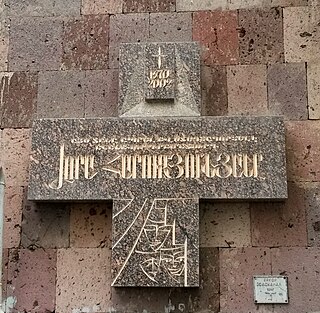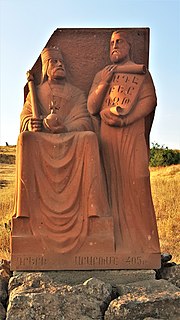See also
| This page or section lists people that share the same given name. If an internal link led you here, you may wish to change that link to point directly to the intended article. |
Ghazar is an Armenian given name. Notable people with the name include:
| This page or section lists people that share the same given name. If an internal link led you here, you may wish to change that link to point directly to the intended article. |

San Lazzaro degli Armeni is a small island in the Venetian Lagoon which has been home to the monastery of the Mekhitarists, an Armenian Catholic congregation, since 1717. It is the primary center of the Mekhitarists, while the Mekhitarist Monastery of Vienna is their primary abbey.

Gugark was the 13th province of the ancient kingdom of Armenia. It now comprises parts of northern Armenia, northeast Turkey, and southwest Georgia.

Yeghishe was an Armenian historian from the time of late antiquity. He was the author of a history documenting the successful revolt of the Armenians in the fifth century against the rule and religion of the Sassanid Persians.
Lazar Serebryakov, or by his birth name Ghazar Artsatagortsian, born in 1795 was a Russian Navy Admiral of Armenian descent. He participated in the Russo-Turkish War, 1828-1829, serving in the Black Sea and Baltic fleets, commanding battleships. In 1838, he laid the foundation of the city of Novorossiysk. He also held top command positions during the Crimean war (1853–1856). He died in 1862.

Bjni, is a village in the Kotayk Province of Armenia. It is situated in a valley between canyon walls and a small river. The village is one of the prominent centers of education and culture of ancient and medieval Armenia. It is the birthplace of the 11th-century scholar Grigor Magistros.

Daniel Varoujan was an Armenian poet of the early 20th century. At the age of 31, when he was reaching international stature, he was deported and murdered by the Young Turk government, as part of the officially planned and executed Armenian Genocide.

Ghazar Parpetsi was a 5th to 6th century Armenian chronicler and historian. He had close ties with the powerful Mamikonian noble family and is most prominent for writing a history of Armenia, History of Armenia, sometime in the early sixth century.

Jivani, born Serob Stepani Levonian, was an Armenian ashugh (bard) and poet.

Isahakyan, known as Kharum until the 1820s, and later as Ghazarabad until 1945, is a village in the Shirak Province of Armenia. It was formerly named after Ghazar Agha who organized the defense of the town against the Persians in 1826–1828; later named after poet Avetik Isahakyan, who lived there.

Jrvezh, meaning "waterfall", is a major village in the Kotayk Province of Armenia, located at the eastern outskirts of the capital Yerevan. The village is 45 km south of the provincial capital Hrazdan, and 9 km from the town of Abovyan.

Parpi is a village in the Aragatsotn Province of Armenia. It is home to the 5th-century Tsiranavor Church, with 7th- and 10th-century modifications. There is also S. Grigor or S. Grigor Lusavorich Church and the 7th-century Targmanchats Church located in a medieval-modern cemetery on a hill to the east. Nearby is a cave with a working door, used as a place of refuge between the 16th and 18th centuries.

Zhora "Gevorg" Saghateli Harutyunyan was an Armenian writer and playwright, awarded by the Renowned activist of arts of Armenia official title, the State Prize of Armenia, "Gabriel Sundukian" and "Artavazd" Prizes. Vardan Ajemian was his first supporter as a theater activist. Harutyunyan is an author of many comedies and plays, which were staged in Armenia and abroad. He headed the Playwright's Union of Armenia. Since 1965 he directed the Armenian branch of the USSR Literary Fund. A member of Writers Union of Armenia committee.

Vramshapuh, whose name is also spelt as Vramshapouh, Vramšapuh, Vrhamshapuh, Vram-Shapouh, Bahram Shapur and Bahram-Shahpur served as a Sasanian client king of Arsacid Armenia from 389 until 414, when he died.
Artaxias IV or Artashir IV who is also known as Artaxias, Artashes, Artashes IV, Artashir, Ardases, Ardasir and Artases was a prince who served as a Sassanid client king of eastern Armenia from 422 until 428. Artaxias IV was the last Arsacid king of Armenia and the last person to hold the crown of the ancient Armenian Kingdom.

Akner monastery is a destroyed Armenian monastery near the Eğner village of Adana province of modern Turkey.

Yeghrdut monastery was an Armenian monastery in the western part of Muş province of modern Turkey, approximately 22 km northwest of Muş city.
Khosrov IV, was a Prince who served as a Sassanid King of Arsacid Armenia, which flourished during the second half of the 4th century & first half of the 5th century, from 387 until 389.
Zarer was a Sasanian prince who attempted to seize the throne from his brother Balash in 485. He only appears in the work of the contemporary Armenian historian Ghazar Parpetsi. After the death of Peroz I, Balash was elected as king by the nobility and clergy. Zarer, dissatisfied with the election, rebelled. Balash was thus forced to make peace with his enemy Vahan Mamikonian and sent him at the head of an army to suppress the rebellion of Zarer. Zarer was shortly defeated, and fled to the mountains, but was quickly captured and "shot down like an animal".
The 461 Apahunik' earthquake affected the province of Apahunik', located to the north of Lake Van, in Anatolia.

Arshavir II Kamsarakan was an Armenian prince from the Kamsarakan family. He was the son of Gazavon II, who immigrated to Sasanian-controlled Armenia following the Roman annexation of the western part of historic Armenia. Arshavir II is notable for having taken part in the anti-Sasanian revolt of 451, led by his father-in-law Vardan Mamikonian. He later died about 460. He was succeeded by his son Narses, who later took part in the insurrection of 482 to 484, led by Vardan's nephew Vahan Mamikonian.